The art of being Pope Leo: from a Raphael portrait to the first pontiff to be captured on film
When Robert Prevost took the name Leo XIV after being elected pope on 8 May, much was read into the reference this made to Leo XIII, a late 19th-century reformer and champion of social justice, whose encyclical Rerum Novarum stood up for both employment rights and private property.
Other popes to bear the name have been equally challenging role models, if for very different reasons. The first to bear the name, Leo I, is known as Leo the Great, one of only three popes to have earned that moniker after facing down the would-be invader of Rome, Attila the Hun, in 452. He and the next three Leos were made saints of the Catholic church. As was the combative Leo IX, who in the 1050s presided over the schism between the Roman and Eastern churches and rode into battle against the all-conquering Normans in south Italy.
The name also conjured memories of one of the most distinctive of all papal canvases, Raphael’s 1518-20 group portrait of Pope Leo X with two of his cardinal cousins (one of them a future pope himself). Likewise the prominent part played by the stories of popes Leo I, III and IV in Raphael’s stanze fresco cycle in four rooms in the Vatican’s apostolic palace.
All five Leo-centric scenes painted by Raphael for the stanze depict events, from the 5th to 9th centuries, that capture the central role popes played in the first Christian millennium in dealing with great powers, both militarily and diplomatically. At the time of his death in 1520, Raphael was working to complete that cycle for Leo X, as well as his equally celebrated decoration of the Loggia of Leo X in the same building.
Here are some noteworthy depictions of Leonine popes. They include five Raphael frescoes and cover 1500 years of papal politics and 500 years of art history.
Raphael’s Pope Leo X and cardinals Giulio de’ Medici and Luigi de Rossi (1518-20) Uffizi Gallery. Public domain, via Wikimedia Commons
Raphael, Pope Leo X and cardinals Giulio de’ Medici and Luigi de Rossi (1518-20)
Raphael’s Pope Leo X and cardinals Giulio de’ Medici and Luigi de Rossi (1518-20) is one of the most admired, and striking, of all papal portraits. It depicts the first Medici pope, the son of Lorenzo the Magnificent, presented as an irresistible presence, supported by a family entourage of fellow princes of the Church.
The painting is a reminder of the central role the Medici family played in 15th and 16th-century Italy, as well as of the extent to which they bankrolled the Renaissance. The adamantine, imperturbable, visage that Raphael gives to Leo X is backed up by a painted terracotta head of the same sitter made a few years earlier and now in the collection of the Victoria and Albert Museum (V&A) in London.
Raphael inherited Leo X as a papal client following the death of Julius II in 1513. On the left of the painting is Leo’s cousin, Cardinal Giulio de’ Medici, who acted as de facto ruler of Florence during Leo X’s papacy. As the Renaissance art scholar Sheryl Reiss has demonstrated, Giulio played a key role in art and architectural commissions executed for Leo X, who treated him like a brother, becoming an important client to Raphael. Giulio took the name Clement VII when elected pope himself in 1524, following which he commissioned Michelangelo to paint The Last Judgement for the Sistine Chapel.
From 1513 to 1520, Raphael’s Vatican commissions grew enormously during the pontificate of Leo X. He worked on completing the stanze frescoes that Julius had commissioned as well as taking on the decoration of what is now known as the Loggia of Leo X, overlooking a palace courtyard that adjoins the stanze.
Raphael also took over as architect of the rebuilding of St Peter’s as well as designing the stupendous Villa Madama as a home for dignitaries visiting Rome and as a “suburban” house of resort for the pope. The artist’s large-scale gouache cartoons for tapestries of The Acts of the Apostles (1515-16, the surviving paintings from the set now in the collection of the V&A) were made into tapestries for the Sistine Chapel (1519-21) in the Brussels workshop of Pieter van Aelst.
The group portrait, now in the Musei degli Uffizi, in Leo and Giulio’s home city of Florence, was lent in 2020 to the Covid-disrupted Raphael exhibition at the Scuderie in Rome. There, in a remarkable curatorial coup, it was seen in company with Raphael’s portrait of the artist’s first papal patron, Julius II (1511), lent by the National Gallery, in London.
Raphael, the Stanze frescoes in the apostolic palace, Vatican City, 1512-20
Popes Leo I (who served as pontiff in 440–461), Leo III (795–816) and Leo IV (847–855) feature in five separate scenes of papal derring-do depicted by Raphael in the series of frescoes he painted, with artists from his studio, in a suite of four stanze (rooms) in the Vatican’s apostolic palace (1512-20). These popes Leo found themselves responsible for maintaining the security of Rome and the Italian peninsula in the days of the rampaging Attila the Hun (452AD), the supportive Emperor Charlemagne (800) and acquisitive Saracen raiders from Spain, north Africa or Sicily (846-849).
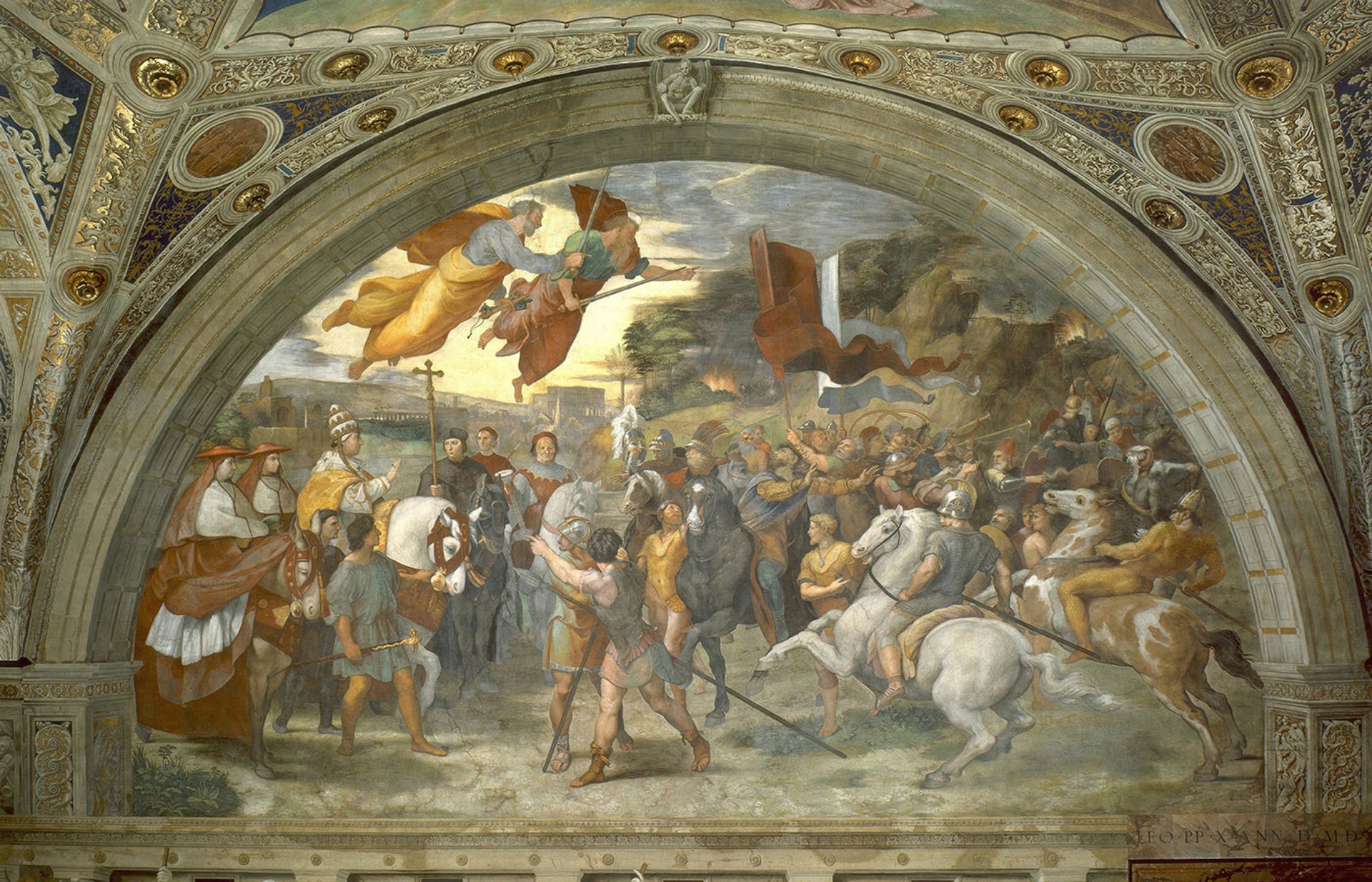
The first Pope Leo: Raphael’s The Meeting of Leo the Great and Attila, 1514, in the Room of Heliodorus, Apostolic Palace, Vatican City Vatican Museums Public Domain, via Wikimedia Commons
Raphael, The Meeting of Leo the Great and Attila, 1512-14
Raphael’s fresco The Meeting of Leo the Great and Attila (1514)—in the Room of Heliodorus in the Apostolic Palace of the Vatican—depicts a fabled moment in 452 AD when Pope Leo I, known as Leo the Great, confronted the all-conquering Attila, ruler of the Huns, near Mantua, in northern Italy. Raphael depicts Leo I, in papal tiara, mounted on a stately white steed, raising his right hand towards the onrushing Huns, as St Peter and St Paul appear miraculously in flight above him, bearing swords. The famously fearless Attila looks up, momentarily awed, at the airborne apostles.
With or without saintly intervention, Leo succeeded in dissuading Attila from invading the Italian peninsula and the Eternal City. Raphael’s original model for Leo I had been Pope Julius II, who had brought the artist to Rome and given him the stanze commission in 1508. Following Julius’s death, Raphael turned to the imposing features of Leo X for his head in profile of the heroic fifth-century pontiff.
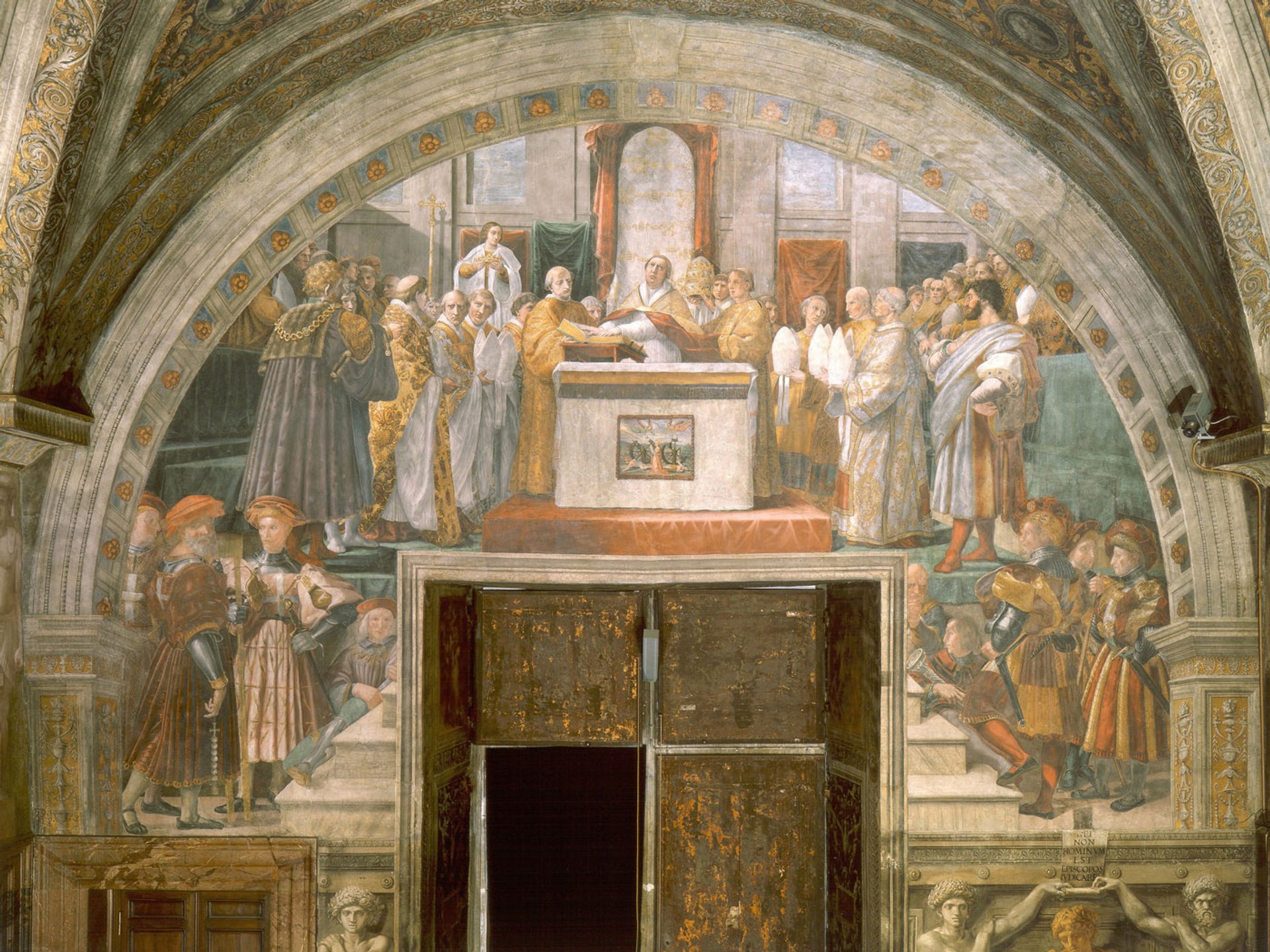
Raphael, The Oath of Leo III, 1514-16, in the Room of the Fire in the Borgo of the apostolic palace, Vatican City Vatican Museums / Public Domain, via Wikimedia Commons
Raphael, The Oath of Leo III, 1514-16
In 799, four years into his papacy, Leo III was accused by the family of his predecessor, Hadrian I, of adultery and perjury. The scene depicted in Raphael’s fresco in the Room of the Fire in the Borgo of the apostolic palace, is the moment when Leo—at a council called in Rome in 800 by the Frankish king, Charlemagne, to resolve the charges—takes an oath of purgation in front of Hadrian’s nephews. The oath—whereby Leo III called on others present to attest to his good character—was successful and, with Charlemagne’s backing, his accusers were banished from the city.
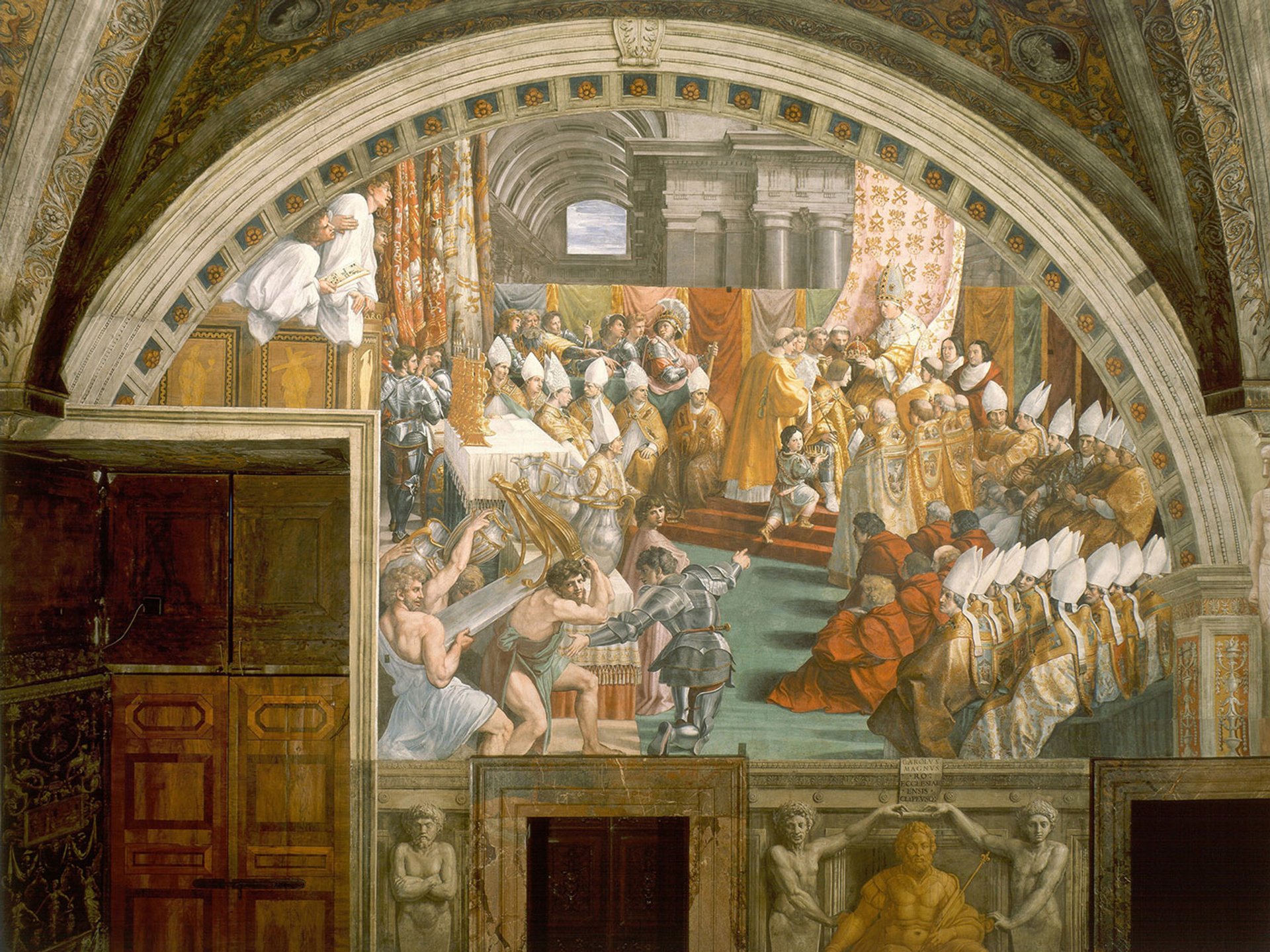
Raphael, The Coronation of Charlemagne (1516-17)—showing the ceremony conducted by Leo III in St Peter’s Basilica in 800—in the Room of the Fire in the Borgo of the apostolic palace, Vatican City Vatican Museums / Public Domain, Wikimedia Commons
Raphael, The Coronation of Charlemagne, 1516–17
On 25 December 800, two days after Leo III had successfully seen off the accusations of his predecessor’s family, he returned the favour by crowning the Frankish ruler as emperor. Raphael’s fresco, in the Room of the Fire in the Borgo, represents an historic moment in European history, one that established a precedent that only the pope could confer the imperial crown. This was built on by successive popes and Frankish rulers to cement the place of a western European Holy Roman Emperor.
Leo’s coronation of Charlemagne as emperor was seen as a gesture of defiance against the rulers of the eastern Roman empire in Constantinople. That rivalrous, divisive, east-west relationship rumbled on for 650 years, until Sultan Mehmed II of the Ottoman Empire conquered Constantinople in 1453.
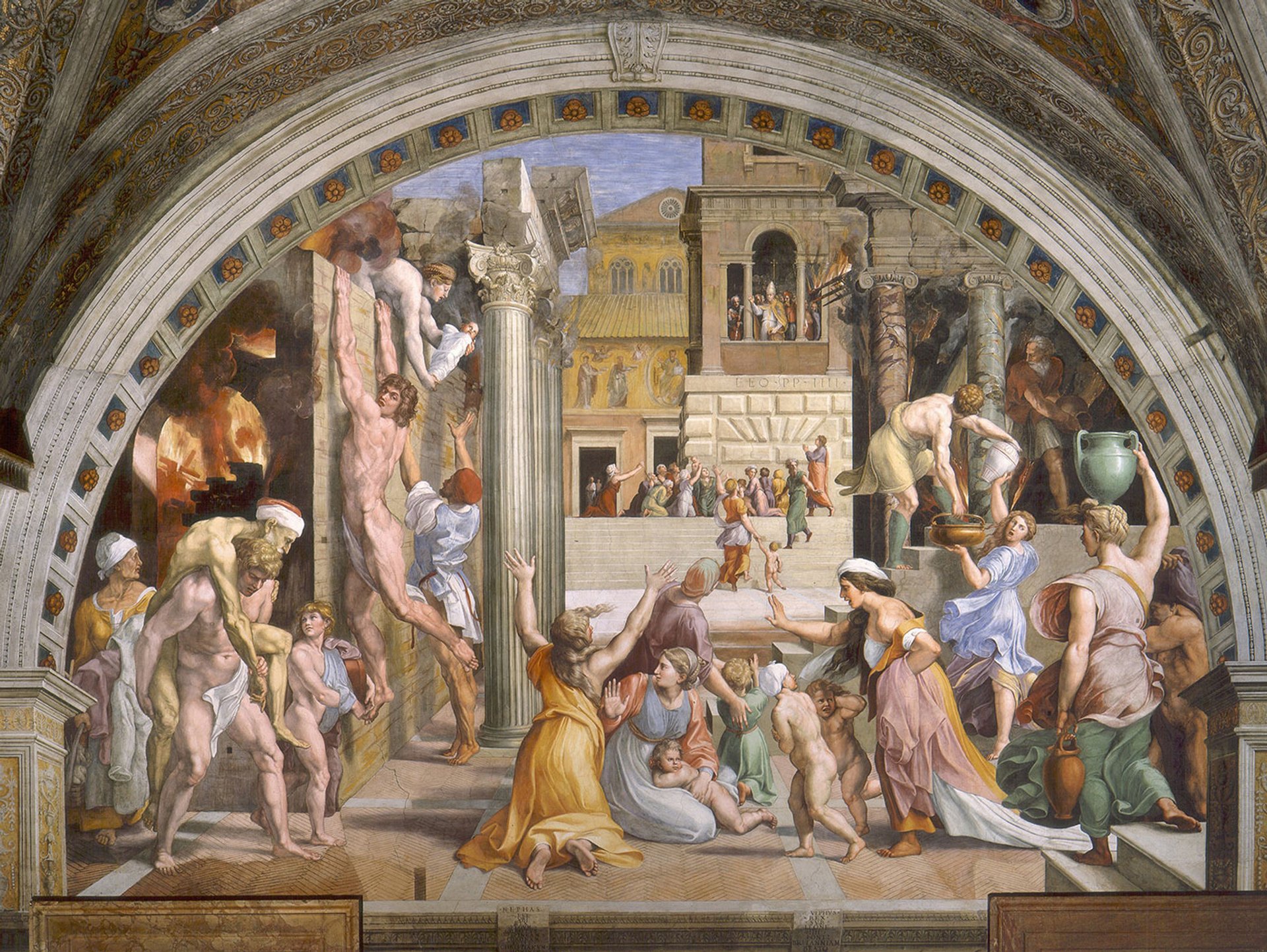
Raphael, The Fire in the Borgo (1514-17)—with Pope Leo IV at an upper window in the background, offering a blessing that reputedly put out the fire in 846—in the Room of the Fire in the Borgo of the apostolic palace Vatican City Vatican Museums / Public Domain, Wikimedia Commons
Raphael, The Fire in the Borgo, 1514-17
The fresco that gives its name to the Room of the Fire in the Borgo captures the scene when Rome was attacked in 846 by Saracen raiders. Pope Leo IV is seen in the background on a papal balcony, offering a blessing which reputedly put out a fire started during the raids. Leo IV is shown standing in a Diocletian window—an example of the artist’s great concern for architecture that included the work of Vitruvius and other masters of ancient Roman building.
Following the raid, Leo built what what was dubbed the Leonine Wall, enclosing an area known as the Borgo on the west bank of the river Tiber, taking in Castel Sant’Angelo as well as the two damaged basilicas. Leo IV built the wall (which was completed in 852 and still survives in a stretch known as the Passetto from the Vatican to the great fortress Castel Sant’Angelo) to improve the city’s defences. He also restored both damaged basilicas, showing himself to be a practical and effective patron of papal built heritage.
When Cardinal Giulio de’ Medici—who was the driving force behind so many of the art and architectural commissions executed by Raphael for his cousin Leo X— looked on the finished fresco in 1517, showing Rome under Saracen attack, he could little have imagined that 10 years later the mutinous, unpaid, army of a Christian ruler, the Holy Roman Emperor Charles V, would carry out the notorious Sack of Rome in 1527. At that moment—when he was three years into his pontificate as Pope Clement VII—Giulio was glad of the 475-year-old Leonine Wall, through which he fled to Castel Sant’Angelo and safety as Charles V’s forces laid waste to the Eternal City.
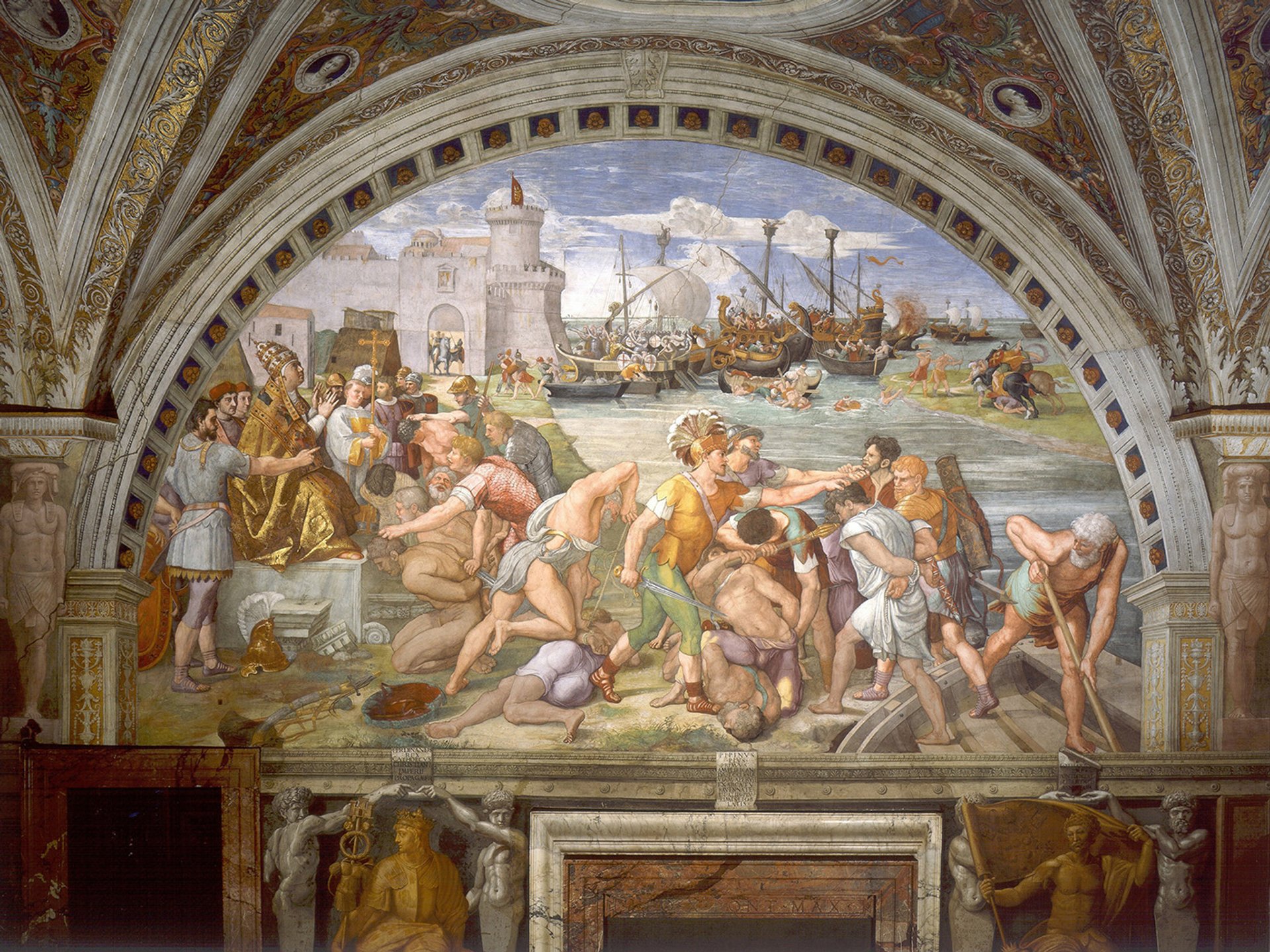
Raphael, The Battle of Ostia (1514-16)—showing Pope Leo IV present at the 849 naval battle where the pope successfully gathered the maritime republics of Gaeta, Naples and Amalfi to see off a Saracen fleet that threatened Ostia, Rome’s port—in the Stanza dell’incendio del Borgo of the apostolic palace, Vatican City Vatican Museums / Public Domain, Wikimedia Commons
Raphael, The Battle of Ostia, 1514-16
In The Battle of Ostia (1514-16), another fresco in the Room of the Fire in the Borgo, Raphael shows Leo IV in the left foreground. He is on shore at Rome’s ancient port of Ostia, following a naval battle in 849 where he had successfully gathered the maritime republics of Gaeta, Naples and Amalfi to see off a Saracen fleet from Sardinia that was threatening Rome’s coastline.
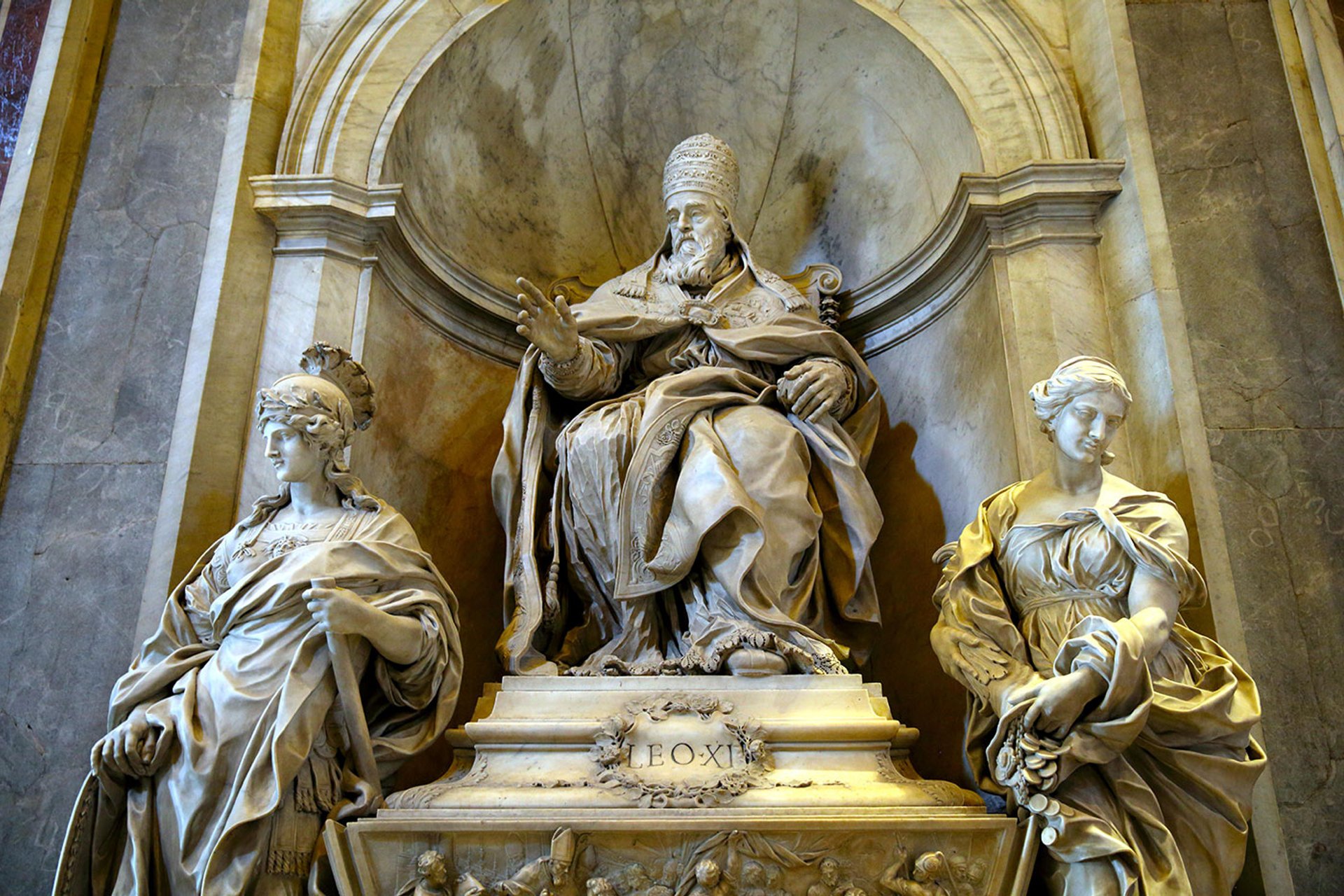
Alessandro Algardi, The tomb of Pope Leo XI, St Peter’s Basilica, 1644 (erected 1652) Russell Mountford / Alamy Stock Photo
Alessandro Algardi, The tomb of Pope Leo XI, St Peter’s Basilica, 1644
Alessandro di Ottaviano de’ Medici, a member of a junior branch of the great Florentine dynasty (he was a second cousin of Cosimo de’ Medici, first Grand Duke of Tuscany), served as Archbishop of Florence for 31 years before being elected Leo XI in 1605. He caught cold at the conclave and was dead within a month of his election. But he had already made his name as archbishop in the seat of his family’s vast network of power and cultural influence. As such he represents—well captured in his overtly Baroque tomb in St Peter’s Basilica by Alessandro Algardi—the confident epitome of the Counter Reformation prince of the Church; determined to push back, politically, liturgically and artistically, against a century of Protestant reform in Europe.
He was also well versed in conclave politics, attending three papal elections before his own. During the election of Niccolo Sfondrati as Pope Gregory XIV, 1590, Medici’s cardinal’s cell—a temporary wooden structure covered in cloth for the duration of the conclave—was situated, with those of seven other cardinals, in half of what is now the Sala Ducale in the apostolic palace. The neighbouring cells included those of Francesco Sforza, who had strongly opposed the bookies’ favourite Marcantonio Colonna before throwing his support behind Sfondrati at the crucial moment. Another was Girolamo Mattei, brother of Caravaggio’s celebrated patron Ciriaco Mattei. As ever in 16th and 17th-century Vatican politics, ecclesiastical and artistic patronage went close in hand.
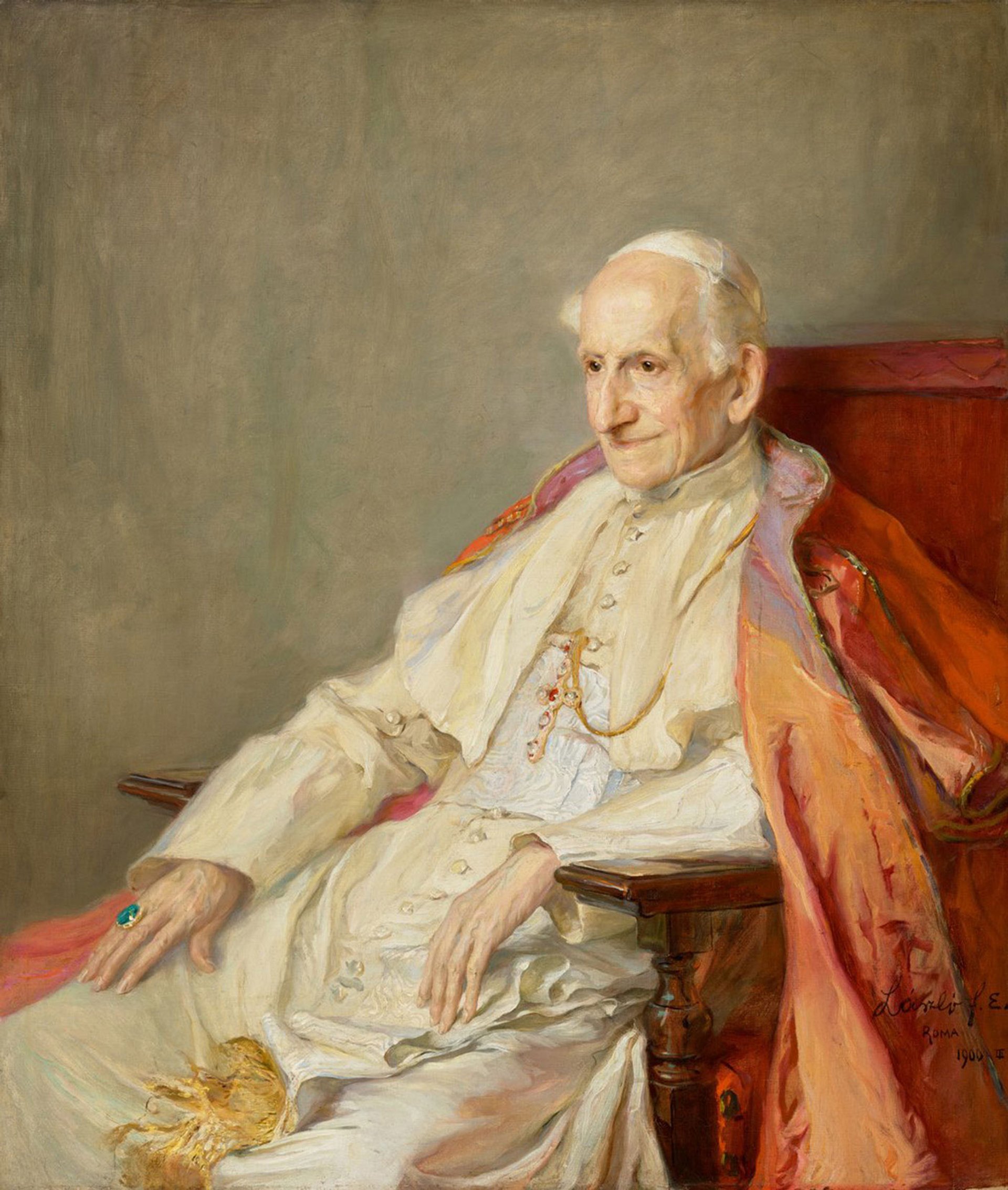
Philip László, Pope Leo XIII (1900) Hungarian National Gallery. Public Domain via Wikimedia Commons
Philip de László, Leo XIII, 1900
Leo XIII (1810-1903) was one of the most consequential popes of past 150 years and one of the defining global figures of the long 19th century, in company with figures such as Queen Victoria and the composer Giuseppe Verdi.
As pope from 1878 to 1903 he lived through the early decades of a unified Italy, ruled by kings from the house of Savoy, of a unified Germany and of a France finally settled as a republic a century after the French revolution. With the papacy reduced in temporal power—and an Italian monarch based in the pope’s former Quirinal Palace—Leo XIII remained a figure of global stature, making great waves with his 1891 papal encyclical, Rerum Novarum, which addressed the economic and societal challenges of its day, and supported employment rights as well as private property.
As a sitter in 1900, Leo seems to have drawn the best out of the fashionable Hungarian portraitist Philip de László—later based in Vienna and London—who has captured his benignly languid disposition and seeing eyes. The artist’s surviving correspondence, published on the De Laszlo Archive Trust website, reveals that Leo XIII had rejected the first version of the portrait as making him look too much like the philosopher Voltaire. This version that is now in the collection of the Vatican Museums.
A second version, now in the Hungarian National Gallery in Budapest, was approved by the sitter. “I can say,” de László wrote at the time of the sittings, “that I have never met a man whose innermost feelings were revealed so expressively.”
Four years before the sitting, the 86-year-old Leo XIII—a noted student of photography—had been filmed in the gardens of the Vatican, becoming the first pontiff to be captured on film, in 1896, just a year after the Lumière brothers had demonstrated their breakthrough film show in Paris. Leo is seen with his nephew Count Pecci, in full military dress, and Monsignor Francesco Salesio Della Volpe, a future cardinal. Leo, who was born on 2 March 1810, is thought to have been the earliest-born person to be captured on film.
For years, the 1896 footage of Leo XIII was thought to have been made by Vittorio Calcina, holder of the Lumière franchise in Italy. In 2023 the Italian historian Gianluca della Maggiore published a new book, Le vedute delle origine su Leone XIII. Vaticano, Biograph e Lumière tra mito e storia (2023), in which he used Vatican sources to confirm the opposing view that the the 1896 scenes had in fact been filmed by the US film-making pioneer William Kennedy Laurie Dickson—of the American Mutoscope and Biograph Company.
The filming had been a success, much approved of by Leo XIII, but the Vatican had later excised any mention of Dickson and his company from their records of the film after discovering that it had been exhibited at fairs or in association with raunchier film titles.




